On this page
Books about the origin of birds and fossil birdsThe books are listed by publication date with the most recent at the top.
|
|
|
|
Birds of Stone: Chinese Avian Fossils from the Age of DinosaursLuis M. Chiappe and Meng Qingjin
Johns Hopkins University Press
2016
"Birds of Stone makes visible the unexpected avian diversity that blanketed the earth just a short time (geologically speaking) after a dinosaur lineage gave rise to the first birds. Our visual journey through these fossils is guided by Luis M. Chiappe, a world expert on early birds, and Meng Qingjin, a leading figure in China's natural history museum community. Together, they help us understand the "meaning" of each fossil by providing straightforward narratives that accompany the full-page photographs of the Jehol discoveries. Anyone interested in the history of life—from paleontologists to inquisitive birders—will find Birds of Stone an irresistible feast for the eyes and mind."
|
Buy from amazon.co.uk 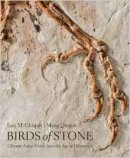
|
|
Avian Evolution: The Fossil Record of Birds and Its Paleobiological SignificanceGerald Mayr
Topics In Paleobiology
Wiley-Blackwell
2016
"Knowledge of the evolutionary history of birds has much improved in recent decades. Fossils from critical time periods are being described at unprecedented rates and modern phylogenetic analyses have provided a framework for the interrelationships of the extant groups. This book gives an overview of the avian fossil record and its paleobiological significance, and it is the only up–to–date textbook that covers both Mesozoic and more modern–type Cenozoic birds in some detail. The reader is introduced to key features of basal avians and the morphological transformations that have occurred in the evolution towards modern birds. An account of the Cenozoic fossil record sheds light on the biogeographic history of the extant avian groups and discusses fossils in the context of current phylogenetic hypotheses. This review of the evolutionary history of birds not only addresses students and established researchers, but it may also be a useful source of information for anyone else with an interest in the evolution of birds and a moderate background in biology and geology."
|
Buy from amazon.co.uk 
|
|
The Rise of Birds: 225 Million Years of EvolutionSankar Chatterjee
Johns Hopkins University Press
2nd edition
2015
"This second edition of The Rise of Birds brings together a treasure trove of fossils that tell us far more about the evolution of birds than we once dreamed possible. With no blind allegiance to what he once thought he knew, Chatterjee devours the new evidence and lays out the most compelling version of the birth and evolution of the avian form ever attempted. He takes us from Texas to Spain, China, Mongolia, Madagascar, Australia, Antarctica, and Argentina. He shows how, in the "Cretaceous Pompeii" of China, he was able to reconstruct the origin and evolution of flight of early birds from the feathered dinosaurs that lay among thousands of other amazing fossils. Chatterjee takes us to where long-hidden bird fossils dwell. His compelling, occasionally controversial, revelations—accompanied by spectacular illustrations—are a must-read for anyone with a serious interest in the evolution of "the feathered dinosaurs," from vertebrate paleontologists and ornithologists to naturalists and birders."
|
Buy from amazon.co.uk 
|
|
Pyramid Valley and Beyond: Discovering the Prehistoric Birdlife of North Canterbury, New ZealandRichard N Holdaway
Turnagra Press
2015
"Describes the original avifauna of North Canterbury as revealed by the fossil evidence in the Pyramid Valley site and other sites in the area, gives the history of the Pyramid Valley site and its environment, and relates the past environment and avifauna to the present landscape."
|
 |
|
Flying Dinosaurs: How Fearsome Reptiles Became BirdsJohn Pickrell
NewSouth Publishing
2014
"The discovery of the first feathered dinosaur in China in 1996 sent shockwaves through the world of palaeontology. Were the feathers part of a complex mating ritual? A stepping-stone in the evolution of flight? And just how closely related is T. Rex to a chicken? In Flying Dinosaurs award-winning journalist John Pickrell reveals how dinosaurs developed flight and became the birds in our backyards. He delves into the latest discoveries in China, the US, Europe and Australia and goes beyond the science to uncover a thriving black market in fossils, infighting between ego-driven dinosaur hunters, and the controversial plan to use a chicken to bring dinosaurs back from the dead."
|
Buy from amazon.co.uk 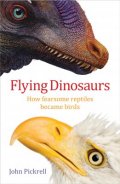
|
|
Avian Ancestors: A Review of the Phylogenetic Relationships of the Theropods Unenlagiidae, Microraptoria, Anchiornis and ScansoriopterygidaeFederico L Agnolín and Fernando Emilio Novas
Springer Verlag
2013
"Although consensus exists among researchers that birds evolved from coelurosaurian theropods, paleontologists still debate the identification of the group of coelurosaurians that most closely approaches the common ancestor of birds. The last 20 years witnessed the discovery of a wide array of avian-like theropods that has considerably amplified the anatomical disparity among deinonychosaurians, some of which resemble Archaeopteryx more than Deinonychus. Among these newly discovered theropods that show remarkable bird-like characteristics are the four-winged theropods Microraptor and Anchiornis, and the unenlagiids Unenlagia, Buitreraptor, and Rahonavis. A bizarre group of minute-sized coelurosaurs, the Scansoriopterygidae, also exhibits some avian similarities that lead some authors to interpret them as more closely related to birds than other dinosaurs. With the aim to explore the phylogenetic relationships of these coelurosaurians and birds, we merged recently published integrative databases, resulting in significant changes in the topological distribution of taxa within Paraves. We present evidence that Dromaeosauridae, Microraptoria, Unenlagiidae, and Anchiornis + Xiaotingia form successive sister taxa of Aves, and that the Scansoriopterygidae are basal coelurosaurians not closely related to birds. The implications in the evolutionary sequence of anatomical characters leading to birds, including the origin of flight, are also considered in light of this new phylogenetic hypothesis."
|
Buy from amazon.co.uk 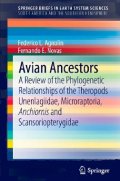
|
|
South American and Antarctic Continental Cenozoic Birds: Paleobiogeographic Affinities and DisparitiesClaudia P Tambussi and Federico J Degrange
Springer Verlag
2012
From the preface: "This book is the compilation of nearly 30 years of fascination for fossil birds and their evolution. That fascination has maintained my enthusiasm for research on all aspects of birds to the present day. Fortunately, 10 years ago my colleague Federico 'Dino' Degrange added his own enthusiasm. The purpose of this book is to provide a synthesis of the fossil bird record of South America and Antarctica through Cenozoic, considering the geologic forces and climatic–environmental forces that may have shaped its evolution. The central point is on terrestrial or arboreal birds, but some considerations on aquatic (continental or marine) birds are also made. The temporal focus is on the Paleocene through Pliocene times. The book begins with a preview (Chaps. 1–4), in which the scope, conceptual, geological, and paleogeographic framework are laid out. The rest is arranged into five main sections. Three chapters compile the information about the main fossil localities chronologically organized. The penultimate Chapter deals with the zoophagous guild, analyzing the record of 13 associations and evaluating the possible dominance of zoophagous over other guilds. The final chapter deals with Bio-Connections of South America and Antarctica with Other Continents and therefore addresses some issues on bird biogeography."
|
Buy from amazon.co.uk 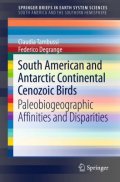
|
|
A Field Guide to Mesozoic Birds and Other Winged DinosaursMatthew P Martyniuk
Pan Aves
2012
"A field guide to mesozoic birds and other winged dinosaurs, a new book written and illustrated by paleoartist Matthew P. Martyniuk, is a comprehensive guide to the diverse fossil species spanning the evolutionary transition from the first feathered dinosaurs with wings in the mid-Jurassic period 160 million years ago, to the late Cretaceous period and the first modern birds. Each caenagnathiform ("oviraptor"), deinonychosaurian ("raptor"), enantiornithean ("opposite bird"), and other winged prehistoric bird species is illustrated in multiple views with distinguishing characteristics highlighted, allowing readers to experience how these species may have differed from each other in life. The illustrations and technical descriptions in this guide will illuminate the various pathways and side branches bird evolution followed during its first 100 million years."
|
Buy from amazon.co.uk 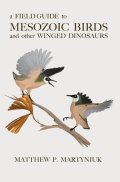
|
|
A History of Polish BirdsZygmunt Bochenski, Zbigniew M. Bochenhski, Teresa Tomek
Institute of Systematics and Evolution of Animals, Polish Academy of Sciences
2012
"A History of Polish Birds is the first book to summarize our knowledge of bird remains from all fossil and subfossil sites in Poland, compare it with books and papers on the fauna of Poland published since the 16th century, and contrast this with the recent status of each species. It should prove to be an invaluable resource for avian palaeontologists, zooarchaeologists and ornithologists, as well as serious birdwatchers who wish to broaden their knowledge."
|
 |
|
Riddle of the Feathered Dragons: Hidden Birds of ChinaAlan Feduccia
Yale University Press
2012
"Examining and interpreting recent spectacular fossil discoveries in China, paleontologists have arrived at a prevailing view: there is now incontrovertible evidence that birds represent the last living dinosaur. But is this conclusion beyond dispute? In this book, evolutionary biologist Alan Feduccia provides the most comprehensive discussion yet of the avian and associated evidence found in China, then exposes the massive, unfounded speculation that has accompanied these discoveries and been published in the pages of prestigious scientific journals. Advocates of the current orthodoxy on bird origins have ignored contrary data, misinterpreted fossils and used faulty reasoning, the author argues. He considers why and how the debate has become so polemical and makes a plea to refocus the discussion by 'breaking away from methodological straitjackets and viewing the world of origins anew'. Drawing on a lifetime of study, he offers his own current understanding of the origin of birds and avian flight."
|
Buy from amazon.co.uk 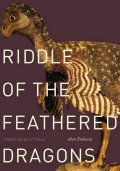
|
|
Written In Stone: The Hidden Secrets Of Fossils And The Story Of Life On EarthBrian Switek
Icon Books
2011
"Darwin’s theory was for more than a century dogged by a major problem: the evidence proving the connections between the main groups of organisms was nowhere to be found. By the 1970s this absence of ‘transitional fossils’ was hotly debated; some palaeontologists wondering if these ‘missing links’ had been so quick that no trace of them was left. However, during the past three decades fossils of walking whales from Pakistan, feathered dinosaurs from China, fish with feet from the Arctic Circle, ape-like humans from Africa, and many more bizarre creatures that fill in crucial gaps in our understanding of evolution have all been unearthed. These discoveries have revolutionised the way in which the fossil record is read to make sense of life on Earth, including the evolution of human beings."
|
Buy from amazon.co.uk 
|
|
Living Dinosaurs: The Evolutionary History of Modern BirdsEditor: Gareth Dyke and Gary W. Kaiser
Wiley-Blackwell
2010
"Living Dinosaurs offers a snapshot of our current understanding of the origin and evolution of birds. After slumbering for more than a century, avian palaeontology has been awakened by startling new discoveries on almost every continent. Controversies about whether dinosaurs had real feathers or whether birds were related to dinosaurs have been swept away and replaced by new and more difficult questions: How old is the avian lineage? How did birds learn to fly? Which birds survived the great extinction that ended the Mesozoic Era and how did the avian genome evolve? Answers to these questions may help us understand how the different kinds of living birds are related to one another and how they evolved into their current niches. More importantly, they may help us understand what we need to do to help them survive the dramatic impacts of human activity on the planet."
|
Buy from amazon.co.uk 
|
|
Cladistics and the Origin of Birds: A Review and Two New AnalysesFrances C James and John A Pourtless
Ornithological Monographs 66
American Ornithologists' Union
2010
A 78 page paper.
|
Buy from amazon.co.uk 
|
|
The Artist and the Scientists: Bringing Prehistory to LifePeter Trusler, Patricia Vickers-Rich, Thomas H. Rich
Cambridge University Press
2010
Includes chapters on Moas and Mihirungs.
"The Artist and the Scientists: Bringing Prehistory to Life presents the extraordinary lives and works of eminent paleontologists Patricia Vickers-Rich and Tom Rich, and Peter Trusler, one of the finest artists of scientific realism Australia has produced. Over more than thirty years, Patricia, Tom and Peter have travelled across Eastern Europe, Asia, the Americas, Africa, Australia and New Zealand in search of the remains of early life, including fish, dinosaurs, birds and mammals. Their successful expeditions, and the many publications and exquisite artworks that have ensued, are a testament to their scientific methodology, thirst for knowledge and eye for detail. The book follows the development of selected works of art covering the last 600 million years of the geological record. Told from the viewpoints of both scientist and artist, the reader is given a unique insight into the process of preserving and recording the evolution of prehistoric life."
|
Buy from amazon.co.uk 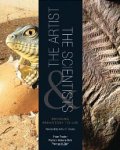
|
|
Paleogene Fossil BirdsGerald Mayr
Springer
2009
"The present book is the first detailed review of the Paleogene avian fossil record on a worldwide scale. Numerous well-preserved fossil bird remains from this geological period, which covers the time span from the end of the Mesozoic era to the beginning of the Miocene, have been described in the past two decades. Some of these not only provide information on morphological transformations in the evolutionary history of the extant avian taxa, but are also of great significance for an understanding of their historical biogeography. Others represent extinct taxa which sometimes show a bizarre morphology not found in modern birds, such as the giant pseudo-toothed birds which reached wingspans up to six meters. The reader is introduced to basic morphological features of the various groups which, as far as possible, are placed into a phylogenetic context in the light of current hypotheses on the interrelationships of extant birds. In a concluding chapter the biogeographical significance of Paleogene fossil birds and possible reasons for faunal changes during the Paleogene are detailed."
|
Buy from amazon.co.uk 
|
|
Feathered Dinosaurs: The Origin of BirdsJohn Long and Peter Schouten
Oxford University Press
2008
"Scientists have recovered more than a billion fossils, but no discovery has been more breath-taking than the fossils recently found in northern China, findings which prove that several families of dinosaurs had feathers, or feathery hair-like coverings, adorning their bodies. Now in the beautifully designed Feathered Dinosaurs, paleontologist John Long and illustrator Peter Schouten provide a stunning visual record of these extraordinary prehistoric creatures, illuminating the evolutionary march from primitive, feathered dinosaurs through to the first true flying birds. Schouten, an acclaimed natural history artist, has created 80 full-colour paintings that capture the striking physical traits of these feathered dinosaurs. Drawing on his extensive knowledge of the lifestyles of modern birds and mammals, plus the extant scientific data regarding how these dinosaurs might have looked and behaved, Schouten has produced not only the most beautiful but also the most accurate visual representations of these animals in print. Equally important, John Long, a noted paleontologist and widely published science author (with some 24 books to his credit), provides an engaging companion text that places these feathered dinosaurs within the larger family of dinosaurs - for instance, outlining their relationship to T. Rex and Velociraptor, species well known to Jurassic Park fans. He discusses the factual information that can be deduced from their fossil remains, in effect providing an insightful natural history of this remarkable group. A true marriage of art and science, Feathered Dinosaurs presents an unprecedented visual record of one of the most significant breakthroughs in the history of vertebrate paleontology - the discovery that many predatory dinosaurs were cloaked with feathers, perhaps just as colorful and fanciful as those of their living relatives."
|
Buy from amazon.co.uk 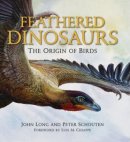
|
|
The Jehol Fossils: The Emergence of Feathered Dinosaurs, Beaked Birds and Flowering PlantsEditor: Mee Mann Chang, Pei-ji Chen, Yuan-Qing Wang and Yuan Wang
Academic Press
2008
"No other single volume reference to the Jehol site and its fossils exists and nowhere is there such a collection of fine photos of the fossils concerned. This book has pieced together the most up-to-date information on the Jehol Biota, a place that has shown the world some of the most astonishing fossil finds including the first complete skeleton of Archaeopteryx in 1861, four-winged dinosaurs- many feathered ones, the first beaked bird, the first plants with flowers and fruits, and thousands of species of invertebrates. Authors shed new light on a number of interesting theoretical issues in evolutionary biology today, such as the origin and early evolution of some major taxonomic groups. The first two chapters give an inviting introduction to the Jehol Biota in terms of its history of study, its main components, its scientific importance, its geographical, geological and biostratigraphic framework, and its renowned fossil discoveries. Each of the remaining chapters deals with a particular organismal group of the Biota written by leading experts. The book is lavishly illustrated with nearly 280 illustrations, which include 200 photographs that show the diversity of the taxa and beauty of their preservation. The colored life restorations, elegantly done by some of China's most celebrated scientific illustrators, give a kiss of life to the dead bones."
|
Buy from amazon.co.uk 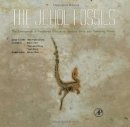
|
|
Glorified Dinosaurs: The Origin and Early Evolution of BirdsLuis M. Chiappe
University of New South Wales Press
2006
"It is within the last few years that it has been established beyond doubt that birds evolved from dinosaurs, with an unparalleled rate of discoveries of early birds and their dinosaurian predecessors from all over the world. Glorified Dinosaurs provides a summary of these discoveries and a discussion of how modern birds evolved from fearsome meat-eating dinosaurs akin to the celebrated Velociraptor. The book focuses on an evolutionary approach and presents current research and fossil discoveries. The title includes coloured photographs of fossils and fossil localities, many of which have been rarely reproduced elsewhere."
|
Buy from amazon.co.uk 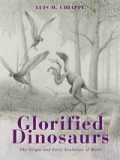
|
|
Amniote Paleobiology: Perspectives on the Evolution of Mammals, Birds, and ReptilesMatthew Carrano
University of Chicago Press
2006
"Living amniotes - including all mammals, birds, crocodilians, snakes, and turtles - comprise an extraordinarily varied array of more than 21,000 species. Found in every major habitat on earth, they possess a truly remarkable range of morphological, ecological, and behavioral adaptations. The fossil record of amniotes extends back three hundred million years and reveals much about modern biological diversity of form and function. A collaborative effort of twenty-four researchers, "Amniote Paleobiology" presents thirteen new and important scientific perspectives on the evolution and biology of this familiar group. It includes new discoveries of dinosaurs and primitive relatives of mammals; studies of mammalian chewing and locomotion; and examinations of the evolutionary process in plesiosaurs, mammals, and dinosaurs. Emphasizing the rich variety of analytical techniques available to vertebrate paleontologists - from traditional description to multivariate morphometrics and complex three-dimensional kinematics - "Amniote Paleobiology" seeks to understand how species are related to each other and what these relationships reveal about changes in anatomy and function over time."
|
Buy from amazon.co.uk 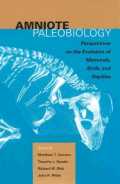
|
|
Pleistocene Fossil Mammals and Birds of Great BritainJoint Nature Conservation Committee
2006
|
Buy from amazon.co.uk 
|
|
Out of Thin Air: Dinosaurs, Birds, and Earth's Ancient AtmospherePeter Ward
Joseph Henry Press
2006
"Biologist and earth scientist Peter Ward now accounts for the remarkable indestructibility of dinosaurs by connecting their unusual respiration system with their ability to adapt to Earth's changing environment - a system that was ultimately bequeathed to their descendants, birds. By tracing the evolutionary path back through time and carefully connecting the dots from birds to dinosaurs, Ward describes the unique form of breathing shared by these two distant relatives and demonstrates how this simple but remarkable characteristic provides the elusive explanation to a question that has thus far stumped scientists. Nothing short of revolutionary in its bold presentation of an astonishing theory, Out of Thin Air is a story of science at the edge of discovery."
|
Buy from amazon.co.uk 
|
|
Mesozoic and Tertiary Fossil Mammals and Birds of Great BritainM.J. Benton, E. Cook and J.J. Hooker
Joint Nature Conservation Committee
2005
"Fossil mammals and birds have been found at many hundreds of localities in Britain, and there is a long history of collection and study, dating back to the earliest days of palaeontology. Many British specimens have been pivotal in major developments in the history of the sciences of palaeontology, comparative anatomy and evolution. British fossil mammal sites range through virtually the entire record of the group, from late Triassic (210 million years ago) to the present day. This volume of the "GCR Series" contains a description of around 30 representative sites, selected for the "GCR" for the Mesozoic-Tertiary part of the history of these vertebrates. The volume is a companion to the "Pleistocene Mammals" "GCR" volume. The geology of each site is described along with the fauna, an interpretation and a comparison with other sites."
|
Buy from amazon.co.uk 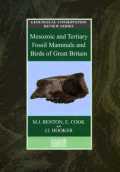
|
|
Unearthing the Dragon: The Great Feathered Dinosaur DiscoveryMick Ellison
Pi Press
2005
"Establishes the revolution in dinosaur science that has occurred in our generation. Dinosaurs are no longer thought of as lizards so much as birds. This transformation is based on excavations in China, changing dinosaurs from Jurrasic Park horrors to warm blooded creatures, attending to their young."
|
Buy from amazon.co.uk 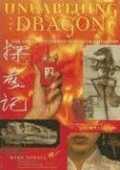
|
|
New Avian Remains from the Eocene of Mongolia and the Phylogenetic Position of the Eogruidae (Aves, Gruoidea)Julia A. Clarke, Mark A. Norell and Demberelyin Dashzeveg
American Museum of Natural History
2005
From the abstract: "A well-preserved nearly complete avian tarsometatarsus was collected by the 2002 expedition of the Mongolian Academy of Sciences from Upper Eocene deposits exposed at the locality of Alag Tsav in the eastern Gobi Desert (Dornogov Aimag) of Mongolia. The new specimen is identified as part of a proposed Eogruidae clade, although it is unclear whether it is appropriately the holotype of a new species within this clade or referable to a previously named species."
|
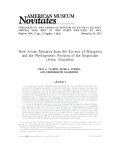 |
|
Vertebrate PalaeontologyM.J. Benton
Blackwell
2004
"Vertebrate Palaeontology is a complete, up-to-date history of the evolution of vertebrates. The third edition of this popular text has been extensively revised to incorporate the latest research, including new material from North and South America, Australia, Europe, China, Africa and Russia. The third edition: highlights astonishing new discoveries including new dinosaurs and Mesozoic birds from China; features an expanded chapter on how to study fossil vertebrates; provides an increased emphasis on the cladistic framework, with cladograms set apart from the body of the text and full lists of diagnostic characters; includes new molecular evidence on early mammal diversification; presents new features to aid study, including new functional and developmental feature spreads, key questions and extensive references to useful web sites The book has a strong phylogenetic focus making it an up-to-date source of the latest broad-scale systematic data on vertebrate evolution." The contents are:
- Vertebrate Origins
- How To Study Fossil Vertebrates
- Early Fishes
- The Early Tetrapods And Amphibians
- The Evolution Of Early Amniotes
- Reptiles Of The Triassic
- The Evolution Of Fishes After The Devonian
- The Age Of Dinosaurs
- The Birds
- The Mammals
- Human Evolution
- Appendix: Classification Of The Vertebrates
|
Buy from amazon.co.uk 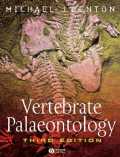
|
|
Feathered Dragons: Studies on the Transition from Dinosaurs to BirdsPhilip J. Currie
Indiana University Press
2004
"Meat-eating theropod dinosaurs have been recognized as potential ancestors of birds since the 19th century, but it was not until the 1960s that work on Deinonychus revealed the startling similarities between dinosaurs and birds. With each new small theropod find the ties became stronger, until the discovery of Sinosauropteryx - a dinosaur with feathers! Though not all scientists accept the concept of birds' being phylogenetically nested within the Dinosauria, others are now focusing on the evolution of feathers and avian flight. This book presents 15 new pieces of research, including the first detailed description of Bambiraptor, a remarkable new specimen from Montana."
|
Buy from amazon.co.uk 
|
|
The Jehol Biota: The Emergence of Feathered Dinosaurs, Beaked Birds and Flowering PlantsEditor: Mee-Mann Chang
Shanghai Science & Technology Publisher
2003
"In the recent years, the late Mesozoic Jehol Biota of northern China has shown the world some of the most astonishing fossil finds ever since the discovery of the first complete skeleton of Archaeopteryx in 1861, and thus has become the focus of many important paeleontological researches in the global arena. These exquisitely preserved fossils not only give us a vivid picture of once a thriving biodiversity but also shed new light on a number of interesting theoretical issues in evolutionary biology today, such as the origin and early evolution of some major taxonomic groups, the origin of feather and avian flight, and the co-evolution of pollinating insects and flowering plants. This book has pieced together the most up-to-date information on the Jehol Biota that is otherwise scattered in the vast technical literature and unavailable to the general readers. The first two chapters give an inviting introduction to the Jehol Biota in terms of its history of studies, its main components, its scientific importance, its geographical, geological and biostratigraphic framework, and its renowned fossil discoveries. Each of the remaining chapters deals with a particular organismal group of the Biota by its leading expert(s)."
|
|
|
Fossil Birds of ChinaHou Lianhai
Yunnan Science and Technology Publishing House
Bilingual: Chinese/English
2003
|
Buy from amazon.co.uk 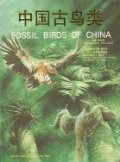
|
|
Mesozoic Birds: Above the Heads of DinosaursEditors: Luis M Chiappe and Lawrence M Witmer
University Of California Press
2002
"Our knowledge of the origin and early evolution of birds has exploded since the late 1980s. In the 1990s alone, scientists became aware of approximately three times more species of early birds than were previously known, marking the first 85 million years of avian development as a period of remarkable species diversity. Assembling work by an international group of scientists, this text provides a wide-ranging source on early avian evolution. It provides a comprehensive examination of the known fossil record and is also a guide to the fast-paced developments in research. The text covers a wide range of topics, including discussions of avian origins, the fossil record of feathers and footprints, bone histology, and locomotor evolution. Controversial taxa such as Protoavis, Caudipteryx, and Mononykus receive special treatment. But the heart of the volume presents the anatomy, relationships, and paleobiology of the Mesozoic aviary. The book features descriptions and illustrations of taxa that previously have received only brief notice, such as the alvarezsaurid Shuvuuia; the enantiornithines Sinornis; Eoalulvis, Vorona, and Patagopteryx; and the hesperornithiform Enaliornis."
|
Buy from amazon.co.uk 
|
|
Bones of Contention: The Fossil that Shook Science
Also published as "Bones of Contention: The Archaeopteryx Scandals"
Paul Chambers
John Murray
2002
"Just when the fuss over Darwin's "Origin of Species" was getting really heated, an extraordinary fossil was found in Germany. Apparently, half bird, half reptile, it was christened Archaeopteryx and hailed as the "missing link" which proved that species could change as Darwin had claimed. The reaction was furious and immediate and has remained so to the present day. Since its discovery the Archaeopteryx has caused more trouble than any other scientific icon. It has been used not just to support dozens of differing views on evolution but to start feuds, destroy reputations, further personal ambition and promote nationalism. "Bones of Contention" tells a story not just about a fossil but about the lengths to which people will go to prove themselves right. Sometimes the consequences are funny, often they are disastrous or tragic, but they are never dull. This is the first book to look not only at the life and times of Archaeopteryx but also at the chaotic scientific world into which it emerged. From Victorian bravado to modern-day media, the meaning and relevance of this humble fossil have changed continually with the times, holiding up a mirror to ideals of science, and attitudes to natural history and the material world. It offers a rare insight into the way scientists can really behave in public and behind closed doors."
|
Buy from amazon.co.uk 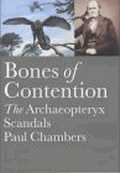

|
|
Chinese Fossil VertebratesSpencer G. Lucas
Columbia University Press
2002
"This book is a comprehensive, chronologically ordered review of China's vertebrate fossil record. It also presents a history of vertebrate paleontological studies in China and an entree to some important issues of systematics, evolutionary history, paleoecology, taphonomy, and functional anatomy best elucidated by China's fossils."
|
Buy from amazon.co.uk 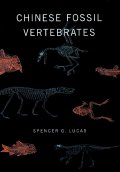
|
|
Dino-Birds: From Dinosaurs to BirdsAngela Milner
Natural History Museum
2002
"This text explores the ever-growing evidence supporting the evolution of dinosaurs to birds. Dinosaur expert Angela Milner looks at the astounding fossil "feathery" dinosaurs from China and the bird fossils from other sights around the world, to take us on a journey from those dinosaurs to the birds we see today. Looking at the people involved and the debates that ensued, this should be an exciting little book packed with information on every page and illustrated throughout."
|
Buy from amazon.co.uk 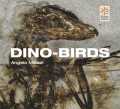
|
|
The Bone Museum: Travels in the Lost Worlds of Dinosaurs and BirdsWayne Grady
Four Walls Eight Windows
2001
"In 1996, a group of Chinese farmers discovered fossils whose skeletons looked like small dinosaurs outlined with feathers. To paleontologist Phil Currie, this finding suggested that the controversial theory that dinosaurs evolved into birds might be true. In The Bone Museum, Wayne Grady recounts his travels with Currie on major digs. Conveying both the environmental challenges and the adrenaline rush of discovery, Grady's tales are a compelling blend of adventure and intellectual quest."
|
Buy from amazon.co.uk 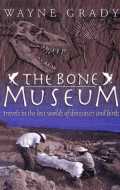

|
|
Catalogue of the Fossil Birds in the British Museum (Natural History)Richard Lydekker
Adamant Media
2001
A facsimile reprint of an 1891 publication by the British Museum, London.
|
Buy from amazon.co.uk 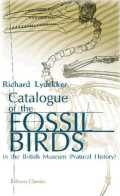
|
|
New Perspectives on the Origin and Early Evolution of Birds: Proceedings of the International Symposium in Honor of John H. OstromEdited by J Gauthier and LF Gall
Peabody Museum of Natural History
2001
A collection of papers presented by leading researchers in paleontology and ornithology at a two-day international conference of the same name, held in New Haven, Connecticut, on February 13 and 14, 1999, along with additional papers not presented at the symposium, for a total of 31 articles. Contents:
- Foreword - Peter Wellnhofer
- Introduction - Jacques Gauthier
- Feathered dinosaurs, flying dinosaurs, crown dinosaurs, and the name "Aves" - Jacques Gauthier & Kevin de Queiroz
- How can we define a feathered dinosaur as a bird? - Ji Qiang & Ji Shu-an
- Phylogenetic relationships among coelurosaurian theropods - Mark A. Norell, James M. Clark & Peter J. Makovicky
- Alvarezsaurids: Birds or ornithomimosaurs? - Paul C. Sereno
- Arctometatarsalia revisited: The problem of homoplasy in reconstructing theropod phylogeny - Thomas R. Holtz, Jr.
- Phylogenetic relationships among basal birds - Luis M. Chiappe
- The basal clades of modern birds - Joel Cracraft & Julia Clarke
- Morphological and molecular support for nonmonophyly of the Galloanserae - Per G.P. Ericson, Thomas J. Parsons & Ulf S. Johansson
- The beginnings of feathers - Alan H. Brush
- Evolutionary implications of possible protofeather structures associated with a specimen of Shuvuuia deserti - Mary Higby Schweitzer
- Methods of inferring unknown aspects of organisms and the behavioral origins of bird flight - E. Nicholas Arnold
- Ecomorphology of avian and nonavian theropod phalangeal proportions: Implications for the arboreal versus terrestrial origin of bird flight - James A. Hopson
- Flight capability and habits of Confuciusornis - Zhonghe Zhou & James O. Farlow
- Stages in the origin of bird flight: Beyond the arboreal-cursorial dichotomy - Kevin Padian
- Forelimb shape and the evolution of birds - Gareth J. Dyke & Jeremy M. V. Rayner
- The wrist of Allosaurus - Saurischia: Theropoda, with observations on the carpus in theropods - Daniel J. Chure
- The function of the manus and forelimb of Deinonychus antirrhopus and its importance for the origin of avian flight - Alan D. Gishlick
- The function of the supracoracoideus muscle during takeoff in the European Starling - Sturnus vulgaris: Maxheinz Sy revisited - Alan J. Sokoloff, Jennifer Gray-Chickering, Jason D. Harry, Samuel O. Poore & George E. Goslow, Jr.
- The evolutionary history of the theropod caudal locomotor module - Stephen M. Gatesy
- Why thrust and ground effect are more important than lift in the evolution of sustained flight - Phillip Burgers & Kevin Padian
- On the origin and evolution of flapping flight aerodynamics in birds - Jeremy M. V. Rayner
- A new perspective on the origin of endothermy - Colleen G. Farmer
- The bone histology of basal birds in phylogenetic and ontogenetic perspectives - Armand de Ricqles, Kevin Padian & John R. Horner
- Functional morphology of the reptilian and avian respiratory systems and its implications for theropod dinosaurs - Steven F. Perry
- Respiratory structure and function in theropod dinosaurs and some related taxa - Terry D. Jones & John A. Ruben
- Were the respiratory complexes of predatory dinosaurs like crocodilians or birds? - Gregory S. Paul
- The false issues of bird origins: An historiographic perspective - Kevin Padian
- Naive falsification and the origin of birds - Peter J. Makovicky & Gareth J. Dyke
- Time and trees: A quantitative assessment of temporal congruence in the bird origins debate - Christopher A. Brochu & Mark A. Norell
- The role of Protoavis in the debate on avian origins - Lawrence M. Witmer
- Biostratigraphy and avian origins in northeastern China - Joshua B. Smith, Jerald D. Harris, Gomaa I. Omar, Peter Dodson & You Hailu
|
Buy from amazon.co.uk 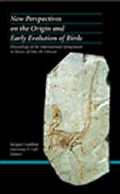
|
|
Dinosaurs of the Air: The Evolution and Loss of Flight in Dinosaurs and BirdsGregory S. Paul
Johns Hopkins University Press
2001
"This text presents the most recent work of evolutionary scientist and dinosaur illustrator, Gregory Paul. It synthesizes the growing body of evidence which suggests that modern-day birds have evolved from theropod dinosaurs of prehistoric times. Paul argues provocatively for the idea that the ancestor-descendant relationship between the dinosaurs and birds can on occasion be reversed, and that many dinosaurs were secondarily flightless descendants of creatures we would regard as birds. The book also offers firsthand interpretations of major fossils; a balanced discussion of the ways we think flight may have evolved (comparing "ground up" and "trees down" scenarios); a close look at the famous urvogel Archaeopteryx, discussing what it can and cannot tell us about bird origins; and in-depth analyses of bird and theropod phylogenetics. Full of detail for the specialist but accessible to the intelligent lay reader, the book includes the author's own illustrations and a technical appendix which provides information, for example, on body mass/wing dimension relationships and avian/dinosaurian metabolics."
|
Buy from amazon.co.uk 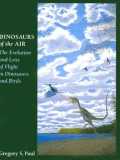
|
|
The Origin and Evolution of BirdsAlan Feduccia
Yale University Press
1999
"From the author of the acclaimed Age of Birds this is an authoritative volume, and profusely illustrated discussion of the origin of birds and of avian flight which draws on fossil evidence and studies of the structure and biochemistry of living birds. Feduccia begins with an overview of bird evolution, giving his opinions about one of the most controversial problems in invertebrate palaeontology - whether birds evolved directly from bipedal, terrestrial dinosaurs or from the precursors of dinosaurs, small arboreal thecodonts perhaps. On the way he provides information about the origin of avian flight and feathers, discusses the most dramatic discoveries in avian palaeontology in the past few decades - the `opposite birds', the dominant landbirds of the Mesozoic - and argues that the evolution of birds followed a similar pattern to that of mammals, an explosive evolution lasting only 5-10 million years. The second half is concerned with the modern evolution of birds, and a comprehensive summary is provided of the evolution of the raptors, the rise of the landbirds, and the evolution of flightlessness."
|
Buy from amazon.co.uk 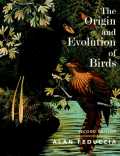
|
|
The Rise of Birds: 225 Million Years of EvolutionSankar Chatterjee
Yale University Press
1999
"This text is a detailed, illustrated review of the fossil record of birds in a modern context. Palaeontologist, Chatterjee, provides a chronology documenting the long odyssey of birds since Protoavis - which may have taken to the air some 75 million years before the widely known "first bird", Archaeopterix. Throughout the text, the author offers details from the history of birds past and present, including: some intelligent theropods such as dromaeosaurs were arboreal and could climb trees with their swivel wrist joint and stiff tail, and glide from tree to ground; the discovery of downy theropod dinosaurs from China indicates that upper jaw mobility, not feathers, is the most distinctive characteristic of birds; and most birds were wiped out 65 million years ago, along with dinosaurs, by large meteoritic impacts. However, a few lineages of birds rebounded from this catastrophe and underwent an explosive evolution. The volume also discussed the significance of the many recently discovered bird and possible bird fossils, from Europe to China to Latin America. Chatterjee outlines varying theories of how animal flight developed and explains, in terms of comparative anatomy, what makes a bird a bird."
|
Buy from amazon.co.uk 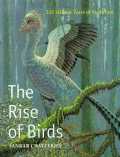
|
|
Avian Paleontology at the Close of the 20th CenturyProceedings of the 4th International Meeting of the Society of Avian Paleontology and Evolution, Washington, D.C, 4-7 June 1996Editor: Storrs L. Olson
Smithsonian Institute Press
1999
From the abstract: "The 32 papers collected herein reflect the great diversity and interest that the study of fossil birds has generated in recent years."
|
Buy from amazon.co.uk 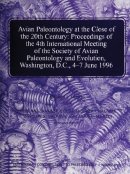
|
|
Taking Wing: Archaeopteryx and the Evolution of Bird FlightPat Shipman
Yale University Press
1999
"Examines the scientific implications and continuing controversy over Archaeopteryx, a bird-reptile fossil discovered 130 years ago that many scientists believe offers tangible proof of Darwin's theory of evolution."
|
Buy from amazon.co.uk 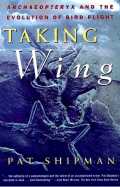
|
|
Pleistocene Birds of the Paleartic: A CatalogueTommy Tyrberg
Nuttall Ornithological Club publication 27
1998
|
Buy from amazon.co.uk 
|
|
Mistaken Extinction: Dinosaur Evolution and the Origin of BirdsLowell Dingus and Timothy Rowe
W.H. Freeman & Company
1997
|
Buy from amazon.co.uk 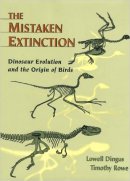
|
|
Papers in Avian Paleontology Honoring Pierce BrodkorbEditor: Kenneth E Campbell
Los Angeles County Museum of Natural History
1992
|
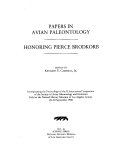 |
|
Recent Advances in the Study of Neogene Fossil BirdsK. Jeffrey Bickart, Robert M. Chandler
Ornithological Monographs 44
American Ornithologists' Union
1990
From the foreword: "The papers in the present volume represent major additions to our knowledge of two of the larger avifaunas of the North American Neogene, that is, the last half of the Tertiary Period, comprising the Miocene and Pliocene epochs spanning the period from about 22.5 million to 1.8 million years ago. Bickart treats an extremely large collection of bones from a Mio-Pliocene lake deposit, the Big Sandy Formation, in Arizona. This collection, made primarily in the 1940s, had lain unstudied for decades, so that virtually nothing was known of the birds from this locality. By contrast, Chandler's study of the late Pliocene San Diego Formation in California continues the elucidation of an avifauna, the studies of which began in 1933 and to which several workers have contributed periodically for half a century. Even so, the number of species in this avifauna is now more than doubled by Chandler's efforts. Each of these fossil avifaunas comprises nearly 40 species. The number of specimens studied was 2,000+ for the San Diego Formation, and to over a thousand in the case of the Big Sandy Formation. Most of the species described are known from many or most of the major skeletal elements, and in some cases, especially in the Big Sandy Formation, from partial or nearly complete associated skeleton."
|
Buy from amazon.co.uk 
|
|
Paleognathous Birds from the Early Tertiary of the Northern HemispherePeter Houde
Nuttall Ornithological Club publication 22
1988
|
Buy from amazon.co.uk 
|
|
Neogene Avian Localities of North AmericaJonathan J. Becker
Smithsonian Institution Press
1987
|
Buy from amazon.co.uk 
|
|
The Cretaceous Birds of New JerseyStorrs L. Olson And David C. Parris
Smithsonian Contributions To Paleobiology, Number 63
Smithsonian Institution Press
1987
From the introduction: "Fossils of Cretaceous birds are scarce and usually difficult to interpret. The better known forms such as Ilesperornis and Ichlhyornis belong to strange and archaic groups having little or nothing to do with the modern avian radiation. The only areas that have yielded Cretaceous birds of essentially modern aspect in sufficient quantities to be regarded as avifaunal assemblages are the inland deposits of the Lance Formation and strata of similar age in Wyoming (Brodkorb, 1963a) and the marine deposits of New Jersey. Of these, the assemblage from New Jersey is the more diverse."
|
Buy from amazon.co.uk 
|
|
Fossil Birds from the Oligocène Jebel Qatrani Formation, Fayum Province, EgyptD. Tab Rasmussen, Storrs L. Olson, and Elwyn L. Simons
Smithsonian Contributions To Paleobiology, Number 62
Smithsonian Institution Press
1987
From the abstract: "Fossils from fluvial deposits of early Oligocène age in Egypt document the earliest known diverse avifauna from Africa, comprising at least 13 families and 18 species. Included are the oldest fossil records of the Musophagidae (turacos), Pandionidae (ospreys), Jacanidae (jacanas), and Balaenicipi- tidae (shoebilled storks). Odier families represented are the Accipitridae (hawks and eagles), Rallidae (rails), Gruidae (cranes), Phoenicopteridae (flamingos), Ardeidae (herons), Ciconiidae (storks), and Phalacrocoracidae (cormorants)."
|
Buy from amazon.co.uk 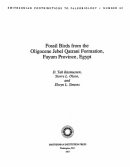
|
|
The Age Of BirdsAlan Feduccia
Harvard University Press
1980
|
Buy from amazon.co.uk 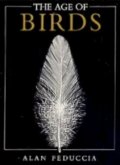
|
|
The Non-Passerine Pleistocene Avifauna Of The Talara Tar Seeps, Northwestern PeruKenneth E. Campbell
Life sciences contributions, no. 118
Royal Ontario Museum
1979
From abstract: "The Talara Tar Seeps are a localized series of fossil-bearing deposits of late Pleistocene age that are located in northwestern Peru, approximately 04°33'S, 81°7'W. The deposits lie on a marine terrace
believed to be of Sangamon age. They have been dated at ca 13,900 B.P."
|
 |
|
Birds of the British Lower EoceneC.J.O. Harrison and C. A. Walker
Brill
1977
|
 |
|
Collected Papers in Avian Paleontology Honoring the 90th Birthday of Alexander WetmoreEditor: Storrs L. Olson
Smithsonian Contributions To Paleobiology, Number 27
Smithsonian Institution Press
1976
From the abstract: "Eighteen papers covering diverse aspects of avian paleontology - from the earliest known bird to extinct species found in Indian middens - are collected here to honor the 90th birthday of Alexander Wetmore. These are preceded by an appraisal of the current state of avian paleontology and of Alexander Wetmore's influence on it, including a bibliography of his publications in this field."
|
Buy from amazon.co.uk 
|
|
Fossil BirdsW. E. Swinton
British Museum (Natural History)
1953
A study of fossil birds from the Jurassic, Cretaceous and Tertiary eras."
|
Buy from amazon.co.uk 
|
|